
























































































































Vientiane Saysettha Development Zone, an exciting new construction project, is located 17 kilometers from the northeast of downtown of Vientiane, the capital city of Laos, covering an area of 1149 hectares. The overall functional scheme of the zone is “One City and Four Areas”, which encompasses a new industrial eco-city making up an international industry cooperation area; a demonstration area of China-Laos cooperation; parts of downtown Vientiane; and a residential area with desirable living spaces. The zone is an embodiment of the close cooperation between China and Laos in implementing the new Belt and Road Initiative, which is a cross-national cooperation project determined by both countries. The development zone is China's only foreign economic and trade cooperation zone in Laos, and a national economic zone to be listed as a project of key planning and prioritized promotion under the construction of the Belt and Road Initiative.
The development zone is part of the 8th Five-Year Plan of Laos, and is an excellent opportunity for Laos to transform itself from a landlocked country to a land-linked one, and rapidly develop its economy. The zone will actively integrate into the Indo-China peninsula economic circle, and will focus on building a platform for international capacity cooperation and support the improvement and upgrading of industry in Southeast Asia to promote the industrialization of Laos and integrative development of ASEAN.


At end of May 2017, the Development Zone Construction has begun to take its shape: the zone gate, arterial road, road network needed for phase I development, o ce blocks (including the Administrative Committee building, LCC o ce building, dormitory building and exhibition hall), the 26 thousand-squaremeter standardized workshop and customer service center is currently in service; infrastructure facilities such as water, electricity and communication networks and television services have been installed. An entrepreneurial incubation central building and dormitory area are also under construction.

At present, 39 enterprises have signed up for settlement in the development zone, with a planned investment of more than 360 million dollars and a land area of over 1300 acres. These enterprises cover the elds of energy and chemical engineering, agricultural and animal products processing, power product manufacturing, building material technology, food processing, tobacco processing, bonded logistics and logistics storage.
Investment operations of the New Hope Group, a leading Chinese agricultural enterprise, have been ongoing for three years. Product Oil Re ning, a project of 1.1 billion yuan co-invested by the Yunnan Investment Holding Group Co., Ltd. and Lao State Fuel Company, is now under construction, and is expected to be put into operation in February 2018.









EXCELLENT
The project is jointly undertaken by China and Laos, and both sides will o er complete support from all sides for the full development of the project.
Laos is located in the ASEAN hinterland, bordering China, Vietnam, Thailand, Myanmar and Cambodia. It's also seated within the ASEAN Free Trade Area, Greater Mekong Sub-region and the Pan Beibu Gulf Economic Cooperation Zone and in the scope of the Belt and Road Initiative.
As a member of the WTO and ASEAN, Laos enjoys preferential tax and quota policies granted by many countries, and has also been listed as a GSP bene ciary state by 38 countries and areas around the world. Meanwhile, as a member of the ASEAN Free Trade Area, Laos also bene ts from a Zero Tari policy when exporting goods to other member states of ASEAN.
The development zone is adjacent to the 450th Anniversary Avenue (leading to the Lao-Thai Friendship Bridge), No.13 National highway (from the north to the south of Laos) and the China-Laos Railway (currently under construction), 15km from the rst Lao-Thai Friendship Bridge, 19km from Wattay International Airport and 10km from the planned new airport. In particular, the China-Laos Railway freight station is only 1km away from the Development Zone, which, when completed, will reduce by a large margin logistics and transportation costs, and accelerate leading industries and capacity within the Development Zone.
A one-stop service platform during the whole process will provide all-round services for investors throughout the entire process, including project inspection in the early stages, project implementation, construction and operation. Established enterprises will also be provided with multiple nancing means and nancial insurance services. Fiscal subsidies and other preferential policies covering tax breaks granted by both sides include: value-added tax (conditional exemption or a 5% reduction), pro t tax (conditional exemption or a 5% reduction), customs duties (conditional exemption) and other tax preferences (contribution for foreign individual income tax will be 5%, contribution for other expenses of taxation or poundage will be half of the original tax payment).
The development will o er support policies such as funding and management to medium and small-sized enterprises, especially to high-tech and sci-tech enterprises for reducing operating costs. At the same time, it will provide personnel training programs, conduct directional personnel training and build a talent training base according to the demand of established enterprises.

Vientiane
Development Zone is shaping up to a true investment hotspot, and the ideal location to establish a new business or build and existing one. We urge enterprises from all over the world to take their part in this exciting new project and help create a better future for Laos.
TEL: +86-0871-67208077 (China) +856-21-766012 (Laos)

President & CEO
Lao Airlines
Dear Passengers,
Welcome aboard, and thank you for choosing Lao Airlines, your home in the sky.
In this issue of our magazine, we are especially proud to present our first female pilot, Ms Soudaphone Visounarath, who began her training with us six years ago, and is now leading the way for more women to choose flying as a career. She has been copiloting the Airbus A320 on domestic and international routes for the past two years.
In response to the increasing number of passengers each year, Lao Airlines will be expanding its flights and expanding its flight destinations so that passengers can enjoy greater comfort and convenience in their travels. After a brief hiatus, we are reinstating the Vientiane-to-Singapore route. Singapore is a modern and civilised city, and you will be amazed at the various tourist sites available there. This route will be available from 29 October.
On behalf of the board and all employees of Lao Airlines, I would like to thank all our passengers for choosing to fly with us, and for your confidence that our airline will continue to expand into the future.
Lao Airlines is always at your service, no matter if you are travelling near or far. We hope to serve you again for your next journey.
We wish you a pleasant flight.
































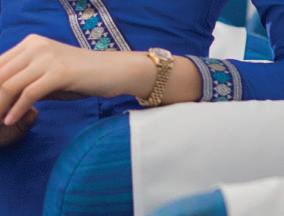





Hello readers,
Welcome to a new edition of Champa Meuanglao, the official Lao Airlines inflight magazine.
It’s now well and truly the rainy season, and the team has been busy compiling this new edition, and finding out more and more about this beautiful and complex country along the way.
There are many fascinating slices of Lao life on these pages. From the whimsical creations of puppeteer Leuthmany Insisiengmay to the complex and creepy new film by Lao filmmaker Mattie Do, this edition has an eclectic range of stories to keep you absorbed on your flight. In this edition, the magazine takes you north, to the new Botanic Gardens in Luang Prabang, and south, to the workshop of fabric dying outfit Laha, whose indigo-dyed products have long been a favourite among Japanese shoppers at popular chain Muji.
And, in keeping with what Laos does best, there is plenty of edible stuff on the pages this time around. On the cover, food and travel writer/ photographer Mick Shippen has delved into the world of wild and foraged food, confounding the expectations of travellers and newcomers with his stunning images of wasp larvae and fried beetles. We also have a tale involving matsutake mushrooms and a World War II Japanese soldier, and an interview with the manager of the institution that is Joma Café and Bakery – Canadian comfort food with a Lao twist. Finally, writer Steven Cleary heads off to Hanoi to sample that city’s famous street food.
Happy reading!
The Publishing Team
Somphone Douangdara
President
Somsamay Visounnarath
Vice President Technical, Operation & Training
Sengpraseuth Mathouchanh
Vice President Planning, Cooperation & International Relations & Legislation
Leuangsamay Leuangvanxay
Vice President Administration, Finance & Accounting
Rada Sunthorn
Vice President Passenger Service, Cargo & Catering
Saleum Tayarath
Vice President Commercial, Tourism


www.champameuanglao.com
Managing Editor Editors
Contributing Editor
Creative Director
Contributing Writers
Head Photographer Contributing Photographers
Director of Marketing & Sales
Marketing & Sales Executive
Headquarters Wattay International Airport Vientiane Capital, Laos Tel: (856-21) 513243-46, Fax: (856-21) 513247 www.laoairlines.com
Follow our official Facebook page at www.facebook.com/laoairlinesofficial to get the latest news and updates from the national carrier of Laos
Disclaimer
Sally Pryor
Cameron Darke
Dalaphone Pholsena Duangtavanh Oudomchith
Jason Rolan
Saphaongern Vongthavilay
Francis Savanhkham
Latsamy Phonevilay
Melody Kemp
Mick Shippen
Ouphachay Thongsamouth
Silvia Luanglath
Souphavanh Aphay
Steven Cleary
Tara Gujadhur
Phoonsab Thevongsa Arounothay Khoungkhakoune
Mick Shippen
Saphaongern Vongthavilay
Steven Cleary
Aditta Kittikhoun aditta.kittikhoun@champameuanglao.com (856-20) 55555521
Duangtavanh Oudomchith duangtavanh.oudomchith@champameuanglao.com (856-20) 55474555
134 Samsenthai Road, Xiengyeun Village, Chanthabouly District, Vientiane Capital, Laos (856-20) 55731717 info@rdkgroup.la
PRINTED BY: Theppanya Printing House
Champa Meuanglao is published bi-monthly for Lao Airlines State Enterprise by SMP Consultants in collaboration with RDK Group. The views and opinions expressed or implied in Champa Meuanglao do not necessarily reflect those of Lao Airlines State Enterprise or its publishing agents. All information in Champa Meuanglao is correct at time of printing. No part of this magazine may be reproduced without the written permission of the publisher.
All rights reserved. Copyright © 2017 by Lao Airlines State Enterprise and SMP Consultants & RDK Group.



























































Features of the school
Planned morning exercise every day
Music and academic exercises every day
Open-design school on more than a hectare of land
Indoor gymnasium and 60 car-parking spots
Private 8m swimming pool
Bilingual English-Lao program
Courses based on Japanese curriculum




Also offering a variety of after-school enrichment classes
- classical ballet
- karate
- Lao traditional dance
- Japanese language
- Soccer



Breakfast at Kung’s
Don’t miss this hidden gem down a ramshackle laneway close to the centre of town. This family-run courtyard eatery, complete with toy dogs and hanging pot plants, serves authentic Lao food with a twist. The sticky rice pancake with mango and honey is a favourite. facebook.com/KungsCafeLao


Lunch at Acqua
This is modern Italian food at its finest. Acqua does a great lunchtime buffet – try the oysters with sea perch and calamari black ravioli, and some macarons for dessert. No reason why you shouldn’t also delve into the excellent wine menu while you’re at it! facebook.com/acqua.laos
Sin dart at Sylom Yen
Try this Lao take on popular Korean barbeque. When done properly, “sin dart” is an interactive culinary journey, from the first sizzle of meat to the bubbling soup that increases in flavor as the meats cook and vegetables and condiments are added as the evening progresses. Best washed down with Beerlao.

Beer, wine and spirits at Spirit House

Afternoon beer at Khop Chai Deu
There’s nothing like a mid-afternoon Beerlao on ice after a busy day of sightseeing. Head over to this Vientiane institution in the centre of town, kick back and do some fine people-watching on the main drag. facebook.com/KhopChaiDeu
An enduring staple of riverside hospitality in the centre of town, Spirit House has a relaxed ambiance and a great range of cocktails. You can watch the sunset from the front tables, or lounge inside when it’s raining.
info@thespirithouselaos.com
Fancy cocktails at Pimenton
This impressive Spanish eaterie serves innovative tapas and classic cocktails, with a revolving menu of specials that continues to surprise. Go for the old-fashioned (but lately revived) negroni, the Perfect Storm, or, if you’re feeling adventurous and showy, go for the Spicy Cucumber, which is exactly what the name suggests, but boozy. facebook.com/pimentonrestaurant



Unwind at Champa spa
To many, having a massage is a luxury, but in Laos, it’s more a part of everyday life – medicinal, rather than indulgent. Champa Spa, which has three branches, is one of many top quality massage spas in Vientiane. Go for the traditional Lao massage, or step it up with the full herbal treatment. Either way, you’ll come out a new you, and smelling amazing too. champaspa.com
Late night drinks at Walking Street Time for a nightcap? Set in an empty shopping complex on the banks of the Mekong, Walking Street, which kicks off at 6.00pm and runs until 10-11pm every night, is an outdoor market dotted with food stalls, pop-up cocktail bars, and off-beat fashion. The laneway vibe is very Melbourne, the fashion is very Bangkok, but the whole experience is 100 percent modern Laos.
facebook.com/walkingstreetlao


Take a tuk tuk safari
There are so many parts of Vientiane that are hidden away, and yet every bit as fascinating as the out-and-out tourist destinations. Tuk Tuk Safari offers small, curated tours of some of the city’s more off-the-beaten track locations, and is one way to experience the city more like a local. facebook.com/tuktuksafari
Pha That Luang
When taking in views of the city, you might notice something glittering gold in the distance - the That Luang stupa. Covered in 500kg of gold leaf, the 45m-high stupa, which dates back to the 16th century, is considered the most important monument in Laos and a national symbol.
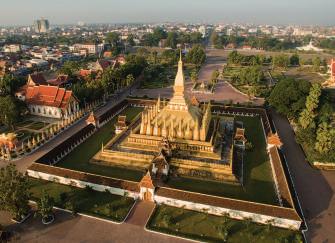

One of Vientiane’s main attractions, Patuxay is reminiscent of the Arc de Triomphe on the Champs Elysees in Paris, positioned one of the city’s wide city avenues. There are mixed narratives around the origin and meaning of the monument, built in the 1950s and 60s, using funds from the American government that were originally intended to build a new airport – hence the monument’s nickname, the ‘Vertical Runway’. Stroll around the fountains and gardens at its base, grab an icecream and climb the stairs in the central tower, for a magnificent panoramic view of the city.
Hor Pha Keo
This elegant ancient temple is in the centre of town close to the Presidential Palace. The site dates back to the 1500s, but the temple was rebuilt in the 1930s. Before then, it was the home of an Emerald Buddha figurine, which remained in the temple for 200 years until 1779, when it was seized by the Siamese General Chao Phraya Chakri. The Emerald Buddha now resides in Bangkok, and the newer temple structure in Vientiane was transformed in the 1970s into a museum that now houses a large collection of Buddhist statues and artefacts.
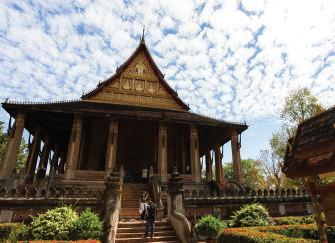


There is grandeur in this view of life... and that, whilst this planet has gone cycling on according to the fixed law of gravity, from so simple a beginning, endless forms most beautiful and most wonderful have been, and are being, evolved. (Charles Darwin)
Darwin would doubtlessly revisit these observations if he visited the botanical gardens in Luang Prabang (Pha Tad Ke), themselves evolving from a wilderness at the base of a limestone hill into a stunningly designed verdant environment.
Visiting four years ago, we whizzed by the indistinct muddy river, landing with a gang of young minority farmers keen to learn composting and cultivation techniques, oblivious to the horticulture staff waving frantically and ineffectively as we passed. The embryonic gardens then comprised a collection of compost heaps, teaching spaces and chaotic fledgling nurseries. How things have changed.
Teaching is central to the Garden’s ethos. School and village groups learn nutrition and are given seeds to propagate. While primarily an educational and research facility, Pha Tad Ke offers visitors an informative respite from temples and shopping. Not to mention really fabulous food. Darwin’s appreciation may explain why an art conservator, a man of creativity and design, was drawn to creating a living art work.
“I finally escaped my life in Europe, travelling for the first time in ages.
I came to Luang Prabang and found this land,” Rik Gadella, Pha Tad Ke’s founder, tells me.


with shell fossils found as high as Phongsaly in the north of the country. It’s natural that Pha Tad Ke’s speciality is limestone botany. International scientists hope the largely inaccessible karst ecosystems remain intact, and are keen to get in and explore what may be the last of these little known universes.
It should be a matter of great pride to Laos that they have such exciting scientific frontiers. We predict lot of discoveries.
“I am an organiser by nature. I like getting people together, blending the technical and creative, but it’s been hard. Even now we are not finished. We need funding for pumps and irrigation, a guesthouse for visiting researchers, to add a specialised orchid nursery…” He sighs, all too aware of the enormity of the task. What he has achieved is all the more remarkable for being largely self-funded.
So, why botany? Bryony Smart, a visiting researcher, leading what might be the first long-term site research study of limestone botany, says, “Plants are everything. Think food, clothes, spices, medicines, building materials. Most of our great discoveries have been around plants and their economic potential.”
“It should be a matter of great pride to Laos that they have such exciting scientific frontiers. We predict lot of discoveries,” says Smart.
“For instance, being so close to China, we are on the lookout for the critically endangered magnolia grandis. We are afraid this and several other species of magnolias in this region will not survive as the forests are almost gone. We hope to find remnants so we can conserve the species. We have caught the attention of the Queen Sirikit Gardens, Xishuangbanna Gardens in China, the Edinburgh Royal Botanic Gardens and the Singapore Gardens who are helping with research and conservation.”






Laos has some of the last remaining
the world; vestiges of old sea floors
Laos has some of the last remaining intact areas of limestone karst in the world; vestiges of old sea floors






Smart, a tall rangy woman whose voice blends New Zealand with Londoner spice, and her colleague Mr Somdy, agree that science has not been good at communicating with the public. So these gardens give new meaning to informative ethnobotany. Circular consecutive gardens display plants normally used in Laos for human and elephant medicaments, food, flavourings, dyes, and - for those with Lady Macbeth inclinationspoisons. You can take a walk into the golden bamboo cathedrals and hear the sounds of birds and the scurrying of reptiles. Increasingly science is showing us that simply being in the forest is good for our wellbeing. The Japanese call it ‘forest bathing’.
Gadella has bigger dreams. “We hope to attract doctoral students to work with Lao botanical staff to foster more research,” he says. “I want to host events like writers’ and ideas festivals to encourage wider discussions on the environment and its increasing relevance to our changing world.”
At the airport, chatty travellers leaving Luang Prabang were dismayed they had missed the gardens. “Damn. I wish we had been told. Now it’s too late.” Don’t make that mistake. It’s easy to get there.

Photos:
Arounothay Khoungkhakoune
pha-tad-ke.com








Phad Tad Ke is a 10-15 minute boat ride from Luang Prabang. The boat leaves the dedicated pier every hour on the hour. The entrance fee is USD25, including the boat. Note that the Gardens are closed on Wednesday. Phone: 071 261000. Find a map at www.pha-tad-ke.com. The office is at the end of the street, the fourth turnoff to the right after Joma.
Note: It may be hard for the disabled to make it down and up the steep banks. Let the staff know if you need assistance.


























ຮູບໂ�ຍ: Arounothay Khoungkhakoune
Pha Tad Ke Botanical Garden - Luang Prabang pha-tad-ke.com




From a small village in southern Laos to an international fashion chain, indigo is a cool colour in more ways than one, writes Silvia Luanglath.

Inspiritual terms, indigo is the colour of intuition and perception. In fashion terms, it’s synonymous with denim – deep of hue and naturally dyed.
It’s also one of the seven colours of the rainbow and has up to seven of its own distinct shades. But did you know that indigo also has mosquito repelling properties, and helps reduce perspiration.
It’s for these reasons, and more, that indigo, derived from the plant of the same name, has been intricately linked to the livelihoods of Lao people for generations. In Laos, indigo is often dubbed “the living colour”, because of the procedures involved in its cultivation, a complex process that involves extracting the liquid from the plant leaves and fermenting it, until a chemical process turns it from a
murky yellow to the deep indigo hue. During this process, great care is taken to ensure the colour does not “die” at each step, and it is then prized for its various practical, rather than simply aesthetic, qualities.



This is especially true for rice farmers, who often wear cotton dyed with natural Indigo. But today, all over the world, fashionable young things are toting bags and wearing jeans and shirts made from “natural-dyed indigo” and hailing from the popular Japanese chain store Muji, which has more than 470 branches worldwide. Most people are unaware of the brand’s long-established link with a workshop in southern Laos, home of the Thonglahasinh Company, which today exports several textile products to Japan.








According to the company’s founder, Bounthong Yodmankhong, the road to this point has been long and winding, beginning when he set up the company with his wife, Songbandith, almost 30 years ago.
Back in 1990, Thongsavanhxay Company, as it was then known, began life as a garment factory in Savannakhet, exporting products to Europe. But when the European Union cancelled a special tax exemption, many foreign investors in Laos had to move their operations to China and Vietnam. Thongsavanhxay was among many local operations that were forced to close. But Bounthong says the move also forced him and his wife to change their business focus, and concentrate more on locally made products that reflected Lao culture.

Songbandith hails from Ban Laha, a small village in Savannakhet Province that has long been associated with indigo and cotton farming. Due to a family heritage of work in the area, she had hundreds of rolls of vintage fabrics scattered throughout the family home. It was these that caught the eye of Maki, a visiting conservationist and textiles expert from Japan, who was introduced to the family by an expert from JICA.
“Mr Maki was interested in Lao weaving culture and saw the beautiful fabrics we’d collected,” Bounthong says.
“He wanted to understand more about the traditional weaving methods of the villagers of Laha from the village elders, and especially about the traditional indigo dyeing methods.”
The idea was to revive the traditional heritage of indigo and Lao cotton weaving, and combine it with modern designs, in a joint Lao-Japanese enterprise. After several years of studying and refining the local craft, the project, led by Bounthong and Maki, was able to export products to Yukenled, a leading import company in Japan, in 1997.


From this, the local Thonglahasing, or ‘Laha’ brand was born, an enterprise that was now large enough to export its products and gain international recognition.
From then on, Bounthong regularly attended international textile exhibitions and trade shows, and it was while attending an exhibition in Japan in 2012 that he met a representative of Muji.
“He was interested in collaborating with the business, and said Muji had been monitoring Laha’s progress for the past 12 years,” Bounthong says.
This partnership led Bounthong, along with the general manager of Muji, on a study tour to India to research traditional Indian methods of indigo dyeing.
“When working with the Japanese, every step must be very detailed and meticulous in order to satisfy their quality standards,” Bounthong says.
“But this didn’t put us off at Laha –we’ve worked hard over the years to prove ourselves to Muji and maintain the relationship.”
Nowadays, the Thonglahasinh Company fills orders worth US$2 million a year for Muji, with the most popular item a simple denim tote bag in varying shades of indigo. The company sends off more than 1
million of these each year, alongside limited edition scarves, pillowcases and cushion covers.
“These products are limited because of the precision required in weaving and dyeing according to Japanese standards, which takes time,” Bounthong says.
“But we’re told they’re highly prized by Japanese customers.”
Today, Bounthong is wearing one of his own indigo shirts – faded and softly worn with age – and muses that the business of textiles is both beautiful and multi-faceted. An avid photographer in his spare time, he says the patience and attention to detail required to capture the perfect image is similar to producing beautiful cotton and indigo fabrics. And both require an appreciation for beauty that millions of people, the world over, can now share.



When working with the Japanese, every step must be very detailed and meticulous in order to satisfy their quality standards.
1. The delicate process of producing indigo
2. Bounthong Yodmankhong
3. Workers at the Laha factory







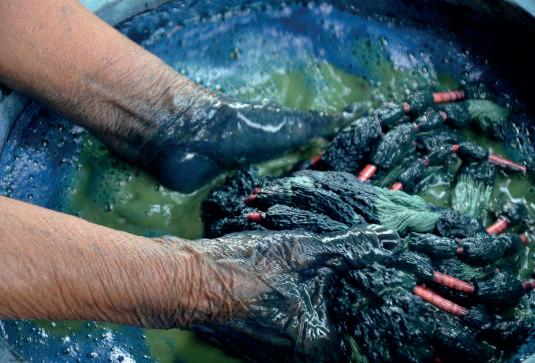
























By Latsamy Phonevilay
It can be hard to say goodbye to a place, especially when you’ve uncovered a special, life-lengthening secret along the way. In 1945, when World War II was ending and the Japanese ended its occupation of Southeast Asia, one Japanese soldier was left behind in Xiengkuang Province.
Maybe he chose not to join his fellow troops as they returned to their home country. But the stories that have been told since are certain of one thing: he stayed in Laos for decades. And when he finally made his way home to Japan and reconnected with his fellow war veterans, he couldn’t help noticing that time had not been kind to them.
He, on the other hand, was strong as an ox, with the vitality of a man far younger than his advancing years. His friends were amazed, and demanded to know his secret.
It was simple, he told them. He had, for all these years, been feasting regularly on the matsutake mushrooms that grow in abundance in Xiengkuang. The same mushrooms that are, even today, considered a delicacy in Japan, purchased as shavings in a side dish, rather than harvested freely under the pine trees.
The story – possibly embellishedhas become part of local Lao lore when it comes to the restaurant and dining trade. But when Xiengkuang native Manola was setting up Kualao Restaurant, five decades after the Japanese left the country, she had no recollection of matsutake – also known as “pine” mushrooms – being anything out of the ordinary when she was growing up. Nor did her own mother. But in her mission to promote the finest Lao cuisine, and out of a love for her home province, she included the mushrooms on the Kualao menu.
Eventually, a Japanese film crew made its way to the restaurant, where they filmed a Japanese tourist feasting on a plate of matsutake.
“I feel like a king, being able to munch on a whole matsutake mushroom like this,” he said. “In my
I feel like a king, being able to munch on a whole matsutake mushroom like this.

country, we only get to eat very, very thin slices. It’s very rare and very expensive in Japan.”
But the film crew was not the first sign of interest from the Japanese. Years before, a Japanese researcher had happened upon an online review of the restaurant, and travelled to Laos to learn more about the origins of the mushroom, already well-known for its medicinal qualities. He travelled with Manola to Xiengkuang and took some soil samples home to Japan, where he determined that these were the exact same species as the ones grown in Japan.
Today, matsutake are known to grow in China, Japan, Korea, Laos, Canada, Finland, Sweden and the United States. In Laos, a steady stream of Chinese and Vietnamese traders travel to Xiengkuang to buy up the sought-after and readily-available mushrooms.
Down in the capital, the mushroom is still widely popular, especially when served infused in traditional Lao whiskey. Kualao is famous for its own version of bottled matsutake whiskey, and was among the first restaurants to promote the mushrooms for their rarity and medicinal qualities. Many wealthy diners will order it to impress their guests, especially senior business and state official.
The restaurant is also, not surprisingly, the Japanese Embassy’s first choice when introducing visiting dignitaries to Lao cuisine; the Crown Prince of Japan and four different Japanese prime ministers have dined there over the years, no doubt regaled by the legend of the youthful World War II soldier who lingered in the north, knowing he was onto a good thing.

“Our hotel is your hotel”
















Discover a destination that combines style and authenticity with the romantic charm of Luang Prabang, a UNESCO World Heritage Centre.
Enjoy peace of mind when it comes to reserving tickets or flight check-ins.











Managed by Lao Airlines, we bring you right from your flight to our door. Peacefully located on the quiet side of town, Muangthong is only a few blocks from Luang Prabang’s main attractions, including Wat Phousi, the Royal Palace, the Prabang Museum and the famous Night Market.























How Joma is lifting the bar in Laos, 20 years on. By Francis Savanhkham





Way back in 1994, a Canadian living in Vientiane opened a bakery. Much and More, as it was then called, had two main reasons for existing. One was to produce and supply sandwich bread to surrounding businesses. But its main purpose was to provide jobs for returning refugees, mainly Hmong people being repatriated into Laos.
More than two decades later, Joma – the name derived from the names of its four founders, Jonathan and Jocelyn, Michael and Aun - is a Lao institution, a legendary fixture in the country’s burgeoning modern café scene, with five branches in Laos, four in Cambodia and three in Vietnam.
From a humble wholesaler, to a café on Vientiane’s then-quiet main drag, to a slick, well-run chain spruiking coffee, bread, pastries and many more things besides, Joma is a comforting constant in a rapidly changing city, and a formidable presence in a market increasingly cluttered with coffee shops and bakeries.
But despite different ownership, two name changes, and a secure place in the urban landscape, the business’ main ethos when it comes to its staff has stayed the same.
Stepping into a Joma café to order something from its extensive and “unapologetically Canadian” menu – staples include a “double-double” (a sandwich whose name is a riff on the Canadian habit of ordering a coffee with two creams and two sugars - a “double double”), taco salad and bestselling “bagel egger” – the average customer would be unaware that many of the staff were entirely unskilled when first hired. Some have disabilities, some are returning from traumatic situations, others were illiterate before fronting up for a job. And this, says country manager Jeff Spohr, is entirely the point.
difficulty getting skilled labour’. And I tell them, ‘I don’t want skilled labour’. Our whole point is we give preferential hiring to people without skills. In fact, if you’ve got a disability, you’re going to get the job first.”
From deaf women baking in the kitchen to supervisors who, when hired, could not even read Lao script, the variety of disadvantaged and low-skilled workers who have worked at Joma is remarkable mainly for how little it affects the actual customer experience.
Joma is a comforting constant in a rapidly changing city, and a formidable presence in a market increasingly cluttered with co�ee shops and bakeries.
“That core of creating jobs for refugees, that has influenced the company a lot,” he says. “Our hiring practice is one of our things I’m most proud of. People will often interview me, and say, ‘I’m just wondering if you have
On a personal level, Spohr is heavily invested in the company’s staff. Another Canadian (and high school friend of one of the original owners), he first visited Laos in 2003 while honeymooning with his wife Alicia, fell in love with the place, and the two returned four years later to help run the Lao side of the business. In the nine years that he’s lived here, he has heard all the negative talk about Laostyle service, and resolutely ignored it.


“I really believe that there isn’t a lot of difference between me and them,” he says, of his staff. “The difference is I had the opportunity of good parents, good schools, good nutrition and good health…I’m not sure that all of those staff we hire have those opportunities. In fact, I’m sure they don’t. If they did, would they be any better at this than me? Yes they would… So if we can start there, all they need is an opportunity and a loving push.”
It’s not surprising that, like many institutions, Joma has a certain mythology attached to it. The original Much and More wholesale bakery morphed into a café called Healthy and Fresh – taking up part of what is now the café’s flagship store in Vientiane’s downtown – which was eventually bought in 1999 by the two couples who comprise Joma. They rebranded the business in 2003, and since then the company’s defining altruism – both in terms of its staff, and the many, many projects it has funded through its business – is for real, and remains constant.
But despite its famous consistency and seamless service, times are changing for Joma. Look around, and suddenly there are cafes on every corner. Other chains that shall remain nameless are popping up in Cambodia and Vietnam. And more, and more, they’re filled with just as many locals as foreigners.
When Joma first opened, its clientele was almost exclusively foreign tourists and expatriates, and market
competition was non-existent.
But, in the past five or six years, there has been a dramatic shift in the people who come through Joma’s doors, from branch to branch, and city to city. And this has led the company to make some adjustments. Regulars will notice subtle (some stalwarts might say dramatic) changes in the menu. There’s a whole new range of salads and sandwiches, five variations on the bagel egger (sales went up noticeably after this one), an almond croissant, doughnuts, baguettes and, in keeping with worldwide “wellness” trends, a range of matcha drinks. Everything, even the jam, is made in-house, and it’s all the result of market research, of responding to a morphing market.
Spohr says much of Joma’s business is focused on raising the bar, both in terms of training staff and giving back to the community. Joma now invests 10 percent of its profits into grassroots initiatives, local communities and projects involving those in need.
But for a long time, Joma didn’t publicise these activities.
“In the beginning, the ‘don’t let your right hand know what your left hand is doing’ principle was very heavily applied - they didn’t tell anybody,” he says.
But that principle no longer applies. Spohr says that with an increased profile comes increased responsibility, and Joma can also set an example.
“The company is showing that good business, ethical business principles and social responsibility in action can also still be done and have profit,” he says. “So we’re trying to raise the bar, and if you do good things and don’t tell anyone, it’s hard to raise the bar. That’s now become [a goal] in the last four or five years, figuring out how to tell people properly about the things that we’re doing…We’re definitely interested in giving back, through the way we run the business but also what we do with the money in the end.”
1. Inside Joma’s second Vientiane branch in Phonthan
2. Joma’s branded coffee
3. The famous bagels
4. Jeff Spohr, Alicia Patenaude Spohr, and staff
Phoonsab Thevongsa
Joma Bakery Café joma.biz


4 ຄົນ Jonathan, Jocelyn, Michael ແລະ
Aun. ປັດຈຸບັນ Joma


4.
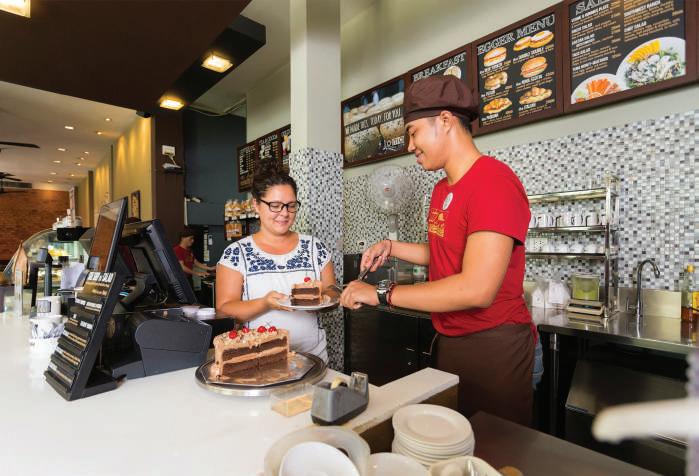























Lao puppet master
Leuthmany Insisiengmay brings discarded objects to life, writes Sally Pryor.



It’s a Sunday afternoon in Vientiane, and visitors dropping into a small art gallery near the centre of town can’t stop smiling. On the walls, and scattered artfully about the room, are all kinds of animals – elephants, chickens, turtles – as well as playful human figures with articulated limbs, and slightly leery masks. At first glance, they are impressionistic, rough approximations of the real thing, rendered mainly in wood. But on closer inspection, most of the objects are made from ordinary garden-andcountryside detritus: fallen coconuts, crumbling concrete, driftwood from the Mekong. It’s an effect both lovely and thought-provoking – how does a piece of bark suddenly become an elephant’s trunk so convincingly? What kind of whimsy does it take to see a turtle in a crumbled piece of cornice?
Leuthmany Insisiengmay, the man behind these creations, is smiling too. He loves seeing people’s reactions to his work, loves the delight they provoke. And on this Sunday afternoon, at the opening of his latest show at Vientiane’s I:cat Gallery, the 63-year-old is once again reflecting on the trajectory of his creative life.
People didn’t always smile at Leuthmany’s creations – at least, not his visual artwork. As a writer, actor and stage director in the Lao Ministry of Culture, Information and Tourism for 10 years during the 1980s and 90s, he honed his craft as an artist and a storyteller. Later, he trained as a clown in France and performed in the Lao National Circus for five years. By then, he had already discovered how much he preferred a visual medium to a spoken one.

“I was in the Ministry of Information and Culture’s drama section for a long time, but when it comes to talking, there will always be people who will never understand the content,” he says. He felt limited by language; foreigners couldn’t understand the stories he was presenting onstage, and he longed for another art form that could transcend these limitations.
Once he began performing in the circus, he realised there were other, more universal ways of communicating ideas. But it was when he discovered a French theatre company using puppets and objects to tell stories that he knew he had found his medium.





“Object theatre doesn’t use any spoken language at all, and this is a medium I like very much,” he says. “The actors really need to express themselves using their body and the objects as an extension, and their ideas need to feed into their acting. The actors are more involved in the process, and that’s what I love about it.”
He returned to France to learn more about puppet performance, how stories are told onstage using objects rather than human figures and words, and eventually, in 2000, established Kabong Lao, the country’s first object theatre, still under the Government ministry.


the reaction from the ministry was dubious.
The actors really need to express themselves using their body and the objects as an extension, and their ideas need to feed into their acting. The actors are more involved in the process, and that’s what I love about it.
“When I first returned from France, and presented our first show, people weren’t impressed,” he says. “As a university graduate, I have many friends from those days who are now government ministers or highranking people, and they’re always asking me why I do what I do. They think I should be doing something else.”
The found objects and discarded household materials he used to for his creations was also something traditional art-watchers and government officials found confronting.
But when it came to making puppets, he relied on his own imagination, and what he had observed at other theatres. His lack of formal training has resulted in a unique style that is both distinctly Lao and immediately recognisable to audiences the world over.
But when he first returned to Laos and began making puppet shows,
“They were used to seeing traditional, shiny, beautifully constructed puppets, and thought my works were not appropriate for touring overseas,” he says. “My work has always been more accepted with the international community, where the concept of using recycled materials is more common.”
His greatest fans are still mostly


foreigners – and on this Sunday afternoon, the I:cat Gallery is filled with expats from all over the world, but few Lao locals – but he says little by little, his message about finding beauty and whimsy in the ordinary landscape is getting through.
And Leuthmany’s journey has not been a solitary one; his son, Lattanakone, or Toh, has followed in his father’s footsteps, right from his high school days, when he began attending Leuthmany’s comedy artist workshops in favour of finishing school.
Toh found himself equally frustrated with the medium, but not for the same reasons.
“I always hated the old-fashioned clown because audiences seemed to look down on him as a crazy character or being so predictable,” Toh said in a past interview. He was with his father when they discovered Turak, the French group that brought Object Theatre to Laos, and together, they travelled to France to train in puppetry.
After travelling and performing with Kabong Theatre for several years, Toh was ready to branch out and form his own object theatre company, Khao Niew, which uses puppets conceived of and made by Leuthmany. Through his company, which receives funding from foreign donors, Toh is trying to preserve the ancient art of “Epok”, “Prateu” or “Bakteu” puppets – an
almost forgotten art that remains integral to Laos’ heritage. But for his part, Leuthmany has always maintained that his productions, while part of an ancient Lao tradition, do not follow any set rules. His avant-garde aesthetic sets him apart from other traditional Lao art forms, bringing dead materials to life. In this sense, he incorporates many Lao superstitions, both Buddhist and Animist, into his storytelling, and brings concepts of the afterlife of objects into a new realm. No wonder Lao audiences were initially shocked by his work.
But Leuthmany has never been deterred by what others think. Using materials that would otherwise be wasted – used for fuel, thrown into landfill or discarded in the river –makes perfect sense to him when it comes to presenting his own country.
“Some might call it ‘trash’ or ‘rubbish’, but it’s these materials that make my creations unique to Laos,” he says.
And, having retired two years ago, he has suddenly found himself with endless time in which to indulge his whimsies and make ever more objects. While he still works as a consultant for Khao Niew, he says his own ideas could stretch on forever. It’s a state of contentment and childlike wonder that seeps into his work and off the walls upon which his work is displayed.
“I’m already 63, and I can see myself doing this for the rest of my life,” he says.
My work has always been more accepted with the international community, where the concept of using recycled materials is more common.


































































































































































Mattie Do’s new film is a love letter to Vientiane and all its complexities, writes Sally Pryor.
Mattie Do doesn’t consider herself a superstitious person. But in Laos, sometimes strange things happen.
Many Lao people believe in the afterlife. They believe the dead can send messages, and that daily life is filled with secret codes and patterns that, once unlocked, can bring great luck to a family. And sometimes this involves money and lottery tickets.
Do, a Lao-Vietnamese-American filmmaker who was born in the US but moved to Laos in 2010, doesn’t subscribe to these beliefs, even while she looks on with fascination – half outsider growing up on the fringes of the Lao expat community in the US, half insider back in her home country.









But even she can’t quite explain away an episode in her youth when, living with her family in America, she awoke in the middle of the night to find her mother moving the furniture –something she does when stressed.
“She said, ‘I had a nightmare that my aunt came to me and she was pale and wet and cold and she was trying to speak to me but I couldn’t understand her’, and everyone said, ‘Just go to sleep, it’s just a nightmare’,” Do says. “And then the phone rang as we were all going back to our bedrooms, and the call was to say the aunt had died from exposure, fishing, because a storm had hit. I’m not a terribly superstitious person, but that is an unforgettable moment for me.”
It’s one of many such things that daily superstitions, contradictions and strange social mores that make up
screenwriter Chris Larsen, even keep
It’s one of many such things that make up the unique perspective of Do in her career as a filmmaker – the only female director in Laos, and the first to make a bona fide horror movie. She has long been intrigued by the daily superstitions, contradictions and strange social mores that make up daily life in Laos; she and her husband, screenwriter Chris Larsen, even keep a running list of such observations, in case they can later sneak them into a film script.
It’s already happened: that longeventually inspire her second feature film, Dearest Sister, screened at
the young, country-mouse cousin who takes advantage of these glimpses into the underworld. It’s a creeping, slow, hauntingly beautiful and ultimately terrifying horror film that also happens to show a side of Laos that has surprised many viewers, especially those in other countries.
On a Tuesday evening in Vientiane, Do and Larsen are drinking cocktails in a downtown bar, and recovering from the film’s Lao premiere the night before. It was the first time the film had screened in Laos, and the first time people who weren’t friends of the couple had seen it.
Do wants to address ingrained stereotypes, both in Laos and from an outsider perspective, about how Lao women should behave.
It’s already happened: that longago premonitory phone call would eventually inspire her second feature film, Dearest Sister, screened at international film festivals to great acclaim, and recently opened in Laos. It’s a ghost story about a young woman in Vientiane who’s slowly going blind, the visions she’s been having, and
It’s a ghost story about a young woman
Do admits she had been particularly nervous in the lead-up. Despite its universally positive reviews overseas, the film is not exactly a flattering portrait of her home country. Some of the most common ‘complaints’ about the film so far, beyond its lack of overt gore, is that it doesn’t show the Laos that people – foreignersexpect. The film is set in modern-day Vientiane – not a rice paddy or rustic village in sight – and the characters live in an urban, materialistic setting. The symbolism, if you know where to find it, shows through vanity plates on luxury cars, smartphones, swanky restaurants, wads of cash. It emerges through the complex social structures that exist in a city filled with ambitious social climbers and rich expats, country relatives expected to fit in, and watchful servants who could snap at any time.

It is, in other words, the Laos that Do knows. And the one that everyone in the cinema recognised at the screening. There were, she says, big laughs at scenes that no one would ever consider funny overseas. In fact, the film’s central premise – that the dead send messages to the living with lottery numbers - has often been regarded dubiously by foreigners.
“[Foreign viewers] don’t understand that the lottery thing is cultural, and they think it’s a goofy plot device,” Do says. “But they walk that back a lot of times when they find out it is a real cultural thing.”
Indeed, she remembers being horrified when, not long after her own mother died, a relative asked her whether she had been “visited” in a dream, and whether her mother’s ghost had given away any numbers. This was before she knew herself how integral such a belief is to daily life in Laos.

“I tell people all the time when I’m travelling and they ask me about the film, that it’s important for me to capture what I see,” she says. “It’s biased, of course it’s biased, I’m a filmmaker, what I put on the screen is going to be from my perspective, and I want to put something as truthful as my perspective that I actually view and observe onscreen. And I see this. This is like everyday life in Laos, especially for someone who is Lao, like me, but who can also take a step back and realise how absurd it is.”
It’s striking that all of the characters in the film are more or less unlikeable, or at least, blinded by self-interest.
And while these character traits are somewhat exaggerated in the script – this is a classic horror film, after all – Do says she wants to address ingrained stereotypes, both in Laos and from an outsider perspective, about how Lao women should behave.

“In society there’s a lot of this - we have to live up to this cultural expectation that Lao girls are pure, demure, long black hair, wear a sinh, do the right thing,” she says. “But the thing is, none of it’s true.”
In reality, modern Lao culture, and the people - especially women – who move within it every day, are complicated. There are layers of tradition and superstition entwined with modernday longings and the trappings of materialism.
But, despite its subject matter, the film is at its heart a love letter to Laos, and to Vientiane especially. It’s there in every throwaway line, close-up of a license plate and in-joke about haircuts and wine glasses: this is the Laos we know, and only those who live here will ever really understand it.
Luckily, this is exactly what many viewers walked away with on that Monday evening, bright with chatter and the thrill of a good horror film. And what did they mostly say to Do?
“The most obvious thing is that they’ve never seen a Lao film that was so beautiful,” she says.
1. Vilouna Phetmany in a scene from Dearest Sister
2. A still from the film
3. Stars Tambet Tuisk and Vilouna Phetmany on set

Lao Construction Bank Limited, a joint venture between private Lao and foreign investors, was officially incorporated and began operations on the 22nd of February, 2012. Over the five years since its inception, the bank has continued to expand, evidenced by the customers who have opened accounts and who regularly use the bank’s services.
When compared to 2013, the total volume of transactions (valued in kip) increased by 9%. In 2014, this increased by 33.19%, and increased continuously to 27.14%. At present, fixed deposit accounts make up 60.25% of the total sum of the bank’s cash deposits, and this is increasing each year.
At the end of 2012, and until the 26th of August, 2016, it has been averaging 21.47% per year, and the bank has been able to make use of this capital to issue credit to investors, businesspeople, retailers, including small-scale, medium-scale and large-scale, in order to play a part in the effective implementation of the 8th Five-Year National Socio-Economic Development Plan (2016-2020), as well as the bank’s business plan as endorsed by the management board.















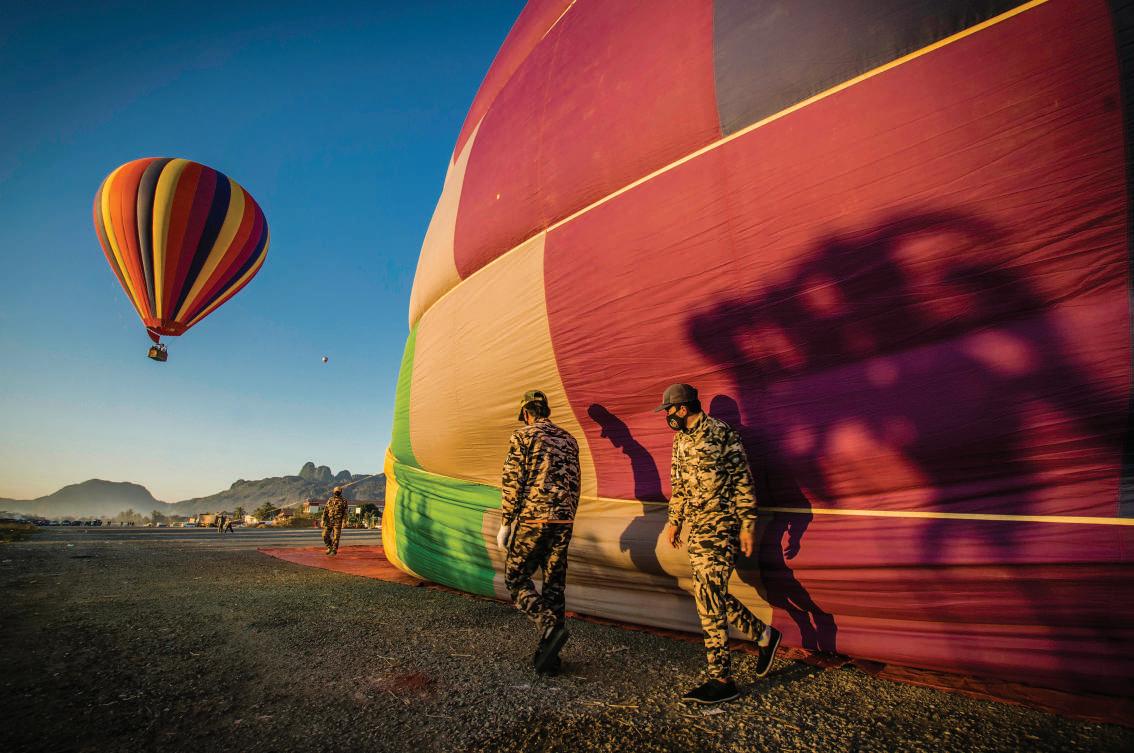




2. Phatang view (Anouphon Phomhacsar)
3. Lao girl collecting wood (Catherine Baraffe-Soudat)
4. Fisherman, Tad Keng Yong (Bill Kiphavong)
5.
Many travellers are surprised to find that Vang Vieng, the tourist hotspot and stop-off town on the way from Vientiane to Luang Prabang, is visually spectacular. The party scene, which once made the town’s reputation, has died down in recent years, and many of the riverside bars and grubby stalls have disappeared. The attention of visitors can now refocus on the spectacular limestone mountains, lush green rice paddies and crisp air.
When hotelier Stéphane Vigié sent out a call for photography of the area for a national competition and eventual exhibition, he wasn’t altogether surprised to receive a veritable flood of entries from all over the country, some 400 in all. What did surprise him, when the entries began pouring in, was their quality, especially those from young Lao photographers – exactly the people he wanted to support.
Indeed, his intention behind the competition and show has been twofold.



My first objective was to promote what I like to call the good side of Vang Vieng.
1. A twilight scene of tourists (Phoonsab Thevongsa)
2. Hmong woman and her cow (Por Thor)
3. Farmers (Catherine Baraffe-Soudat)
4. Dignified Lao man (Yenok Lee)
5. Stéphane Vigié
6. Sinxay Thavixay receiving the Special Jury Prize at Crowne Plaza Vientiane

“My first objective was to promote what I like to call the good side of Vang Vieng,” he says. “I feel that the media, when they are talking about Vang Vieng, are almost exclusively focusing on its development challenges. They lose sight of what really makes Vang Vieng a special place: gorgeous landscapes but also a very interesting history, many ethnic communities and captivating legends.”
Vigié has long been on a mission to highlight Laos’ artistic heritage and visual culture. Today, he is the co-owner of the town’s most stylish hotel, Riverside Boutique Resort, but he first came to Laos to work as Deputy Resident Representative of the United Nations Development Program, advising on the fight
against poverty and inequalities. He quickly realized that many local people understood relatively little about the country’s cultural heritage, let alone the rest of the world.
He opted to stay in the country, and, through his hotel, promote Laos’ rich cultural history. The hotel has regular shows and exhibitions, and the rooms are themed with specific ethnic décor.
Vigié’s second objective when he launched the competition was to support local artists, specifically photographers. “I wanted to try and give visibility to some good young Lao photographers,” he says, adding that he’s noticed over the years that whenever there was a call for professional photography in the country, it was foreigners who


answered it, rather than locals.
Knowing in advance that many prospective entrants, especially the younger ones, would need support, Vigié had organised sponsorship for three separate groups of photographers to travel to the town and immerse themselves in the area.
And, from the quality and diversity of many of the entries, this initiative paid off. From frank and haunting portraits of local residents to startling natural landscape shots, the images on show demonstrate that Vang Vieng has a hold on anyone who visits, even locals who have been travelling through the area their entire lives.
The 24 entries that make up the exhibition, which is showing through August in Vientiane and Vang Vieng, were selected by an international jury of professional photographers, artists and journalists. In a rapidly developing society, many young people – hooked on screens and social media - are nevertheless seeing the world with fresh new eyes. It’s time, says Vigié, to see the world, through this new gaze.
“We were thrilled to receive so many great images,” he says.
“We really hope that this exhibition will help raise awareness about the beauty of Vang Vieng, and also the need to protect and preserve its unique landscapes and traditions.”





















































Innocence Shop: Passport Covers Mob: +85620 7799 0055

LOKO Clothing Store: Tank Top Mob: +85620 7772 2797
Story of head: Bandana Mob: +85620 5238 8523
Night Market: Bracelets
Flip-flops Umbrella Raincoat Earrings


Because the monsoons are finally here! Stay dry and stay stylish with a bit of help from Vientiane’s street fashion scene...

On Air:







Camisole + Skirt
Mob: +856 20 55 010 000
Letmeshop : Make-up
Mob: +85620 7654 2227
Men’s Shop:
Mob: +85620 7796 9499









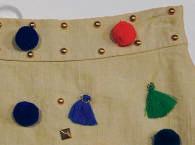
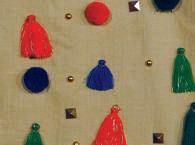































vtessqv@laoairlines.com vtersqv@laoairlines.com onlinebooking@laoairlines.com





















www.laoairlines.com www.facebook.com/laoairlinesofficial






































Europe’s top tables, such as Noma in Copenhagen, have built reputations and garnered Michelin stars on the trend for foraged food and edible insects. But that won’t turn any heads in Laos; such food has always been part of the country’s rich culinary landscape. Intrepid eater Mick Shippen takes a bite on the wild side for Champa Meuanglao.

I have a confession to make. When I have western friends to stay in Vientiane, I like to take them to a Lao restaurant and, without telling them, order a large plate of fried crickets. After the initial surprise, the reaction goes one of two ways –occasionally my dining companion will tuck-in with only the slightest hesitation, but mostly it takes 10 minutes of persuasion before they will tentatively bite into the crispy thorax and abdomen of a short-tailed cricket, known locally as chi nai or nak hong tai din, which translates as “underground singer”. In truth, if you can overcome your initial reluctance to munch on a bug, I assure you that a plate of plump, deep-fried crickets, liberally sprinkled with white pepper, fried kaffir lime leaves, dried chili and fish sauce, make a very tasty accompaniment to the ubiquitous chilled Beerlao. If you are still not convinced, then I urge you to simply consider these tasty morsels as land shrimps!
In addition to being a delicious snack, crickets are highly nutritious and a rich source of essential macronutrients, protein, fat and carbohydrate. Indeed, a recent study by the Food and Agriculture Organization of the United Nations stated that Laos was
among the world’s highest consumers of insects, and stressed the many benefits for health, food security, nutrition, and the environment. Such is the popularity in Laos of crickets, and numerous other types of insects, that they are not only caught in the wild but also farmed commercially, earning villagers a good income.
Laos is predominately a rural and unspoiled country and as such, foraged food has always been an important part of the diet. Ingredients such fiddlehead fern tops, yellow burrhead water iris, hummingbird tree flowers, and many other wild plants, leaves and herbs are liberally used in Lao cooking to create exciting flavours and textures. Foraged herbs are used in soups and curries, while a traditional dish called sup can be made from a wide variety of vegetables seasoned with pounded root ginger, shallots, chili and sesame seeds.
Next time you’re in a Lao restaurant or market, be adventurous. Take a bite on the wild side! Here are 10 edible insects and foraged delicacies from Laos’ wild larder that are worth discovering.














Several types of cricket are farmed in Laos, making them the most common insect species found in markets. At 5cm in length, the short-tailed cricket is the largest field cricket in Asia. They live in burrows in the ground and the males produce a chirping sound when they are active at night, hence the Lao name nak hong tai din, or “underground singer.” Crickets are deep-fried and tossed with herbs and flavourings such as fish sauce, pepper and chili.
khai mot daeng and smaller darker coloured khai mot hai are the eggs of red weaver ants and a black ant, both of which nest in trees. They are without doubt the most popular food from Laos’ wild larder. The ants get their name because they construct nests by weaving leaves together to form a large ball high up in trees. Nutritious and delicious, weaver ant eggs are seasonal and available from January to April, but can be frozen for later use. Dishes include kaeng pa sai khai mod daeng lae phak waan, fish soup with red ant eggs and melientha leaves, khua khai sai khai mot daeng, ant egg omelette, and goy khai mot daeng, spicy ant egg salad.




These 4cm-long bugs, known as duang nor mai, are the caterpillar of the omphisa fuscidentali or bamboo borer moth, which, as the name suggests, lays its eggs in clumps of bamboo. In season from October to January, they are collected in the wild and raised commercially. Considered a delicacy, these protein-rich caterpillars are served fried and are a popular beer snack.
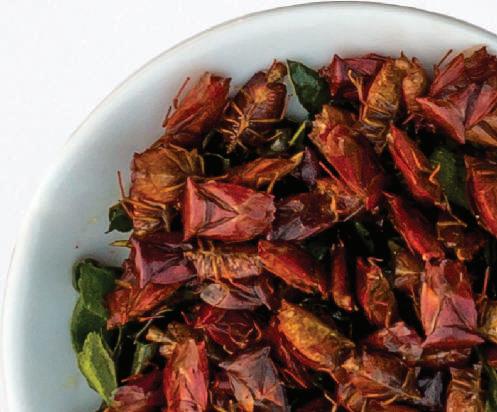












Not all bug collecting is without risks. The larvae of the tree-dwelling giant hornet or tor daan and digger wasp or tor khoum which often nests underground, are highly prized as food, but adult insects are extremely aggressive, making harvesting extremely dangerous, when they are pacified with smoke. As a result, the larvae command a high price when it is in season in June. They can be prepared and eaten in many ways, including steaming with egg and herbs.
Maeng da are the most intimidating-looking of all the edible insects. And be careful if you are tempted to pick one up in the market; they will bite.
Maeng da are the most intimidatinglooking of all the edible insects. And be careful if you are tempted to pick one up in the market; they will bite. The inner flesh of roasted maeng da can added to number of dishes, including a jaew dip in which it is mixed with grilled fish, herbs, and chillies, and pon pa, a fish and vegetable stew. The beetles have a strong fragrance and you may see shoppers in the markets smelling them to select the most aromatic
Known as maeng khaeng in Lao, these colourful little bugs are collected from March to May or June. As a defence, they secret a rather unpleasant smelling liquid which can stain and burn the skin. Maeng khaeng can be fried with herbs and kaffir lime leaves or made into a jaew dip.
Numerous other insects eaten in Laos include dragonfly larvae, dung beetles, scarab beetles, red pal weevil and larvae, cicadas, and more.
1. Crickets
2. Hornet and bee larve
3. Bamboo caterpillars
4. Ant eggs
5. Stink bug
6. Giant water beetle

















The hummingbird tree or is a source of beautiful edible flowers known as dok kare. Trees produce either vivid crimson or creamy white flowers, which are added to soups and curries such as gaeng pa sai dok kare, fish curry with hummingbird tree flowers.
Fiddlehead fern or pak koot is a popular foraged vegetable which is available all year round. The young tender curled tops are used in a sup or yam, a spicy salad flecked with fresh chilis, herbs and minced pork.
Yellow burrhead or pak gang jong is an edible water iris. The flowers and stems prepared at a sup, cooked with garlic, ginger, chillies, shallots and sesame seeds. It is a native of Mexico and here in Laos it is an invasive plant, so you will be doing your bit for the environment by eating it.


The curiously named earthstar barometer mushroom is small leathery puffball-like fungus which is dug from the ground in May and June. This delicious and unusual mushroom has a complex earthy flavour and is served in curries or stir fried with herbs and chili.
Khai phaen is edible riverweed harvested from fast flowing rivers in northern Laos. After collection, it is washed several times to clean it. The weed is spread thinly on a bamboo frame in a process similar to making handmade paper. Thin slices of garlic and tomato, along with a sprinkling of sesame seeds can then be added and the weed left to dry in the sun. To eat, the weed is fried for just a second or two and served with jaew, spicy dips made using the holy trinity of charcoal roasted garlic, shallots and chillies, plus the addition of the star ingredient such as tomatoes, aubergine or mushrooms.



































In Vientiane, fried crickets and other insects can be found at evening food markets near That Luang, and at the junction of Hengboun and Chao Anou roads, and Ban Anou Night Market along Khun Bu Lom Road.
Most foraged vegetables sold in the markets are bought by home cooks. Very few restaurants have them on the menu. Exceptions include Doi Ka Noi in Vientiane, which serves a small daily changing menu, often featuring more unusual seasonal dishes, and Kualao restaurant, also in Vientiane. In Luang Prabang, Tamarind restaurant can offer an “Adventurous Lao Gourmet” menu for advanced bookings which includes some exotic ingredients.
2. Earthstar barometer mushrooms
3. Yellow burrhead water iris
4. Khai phaen
5. Fiddlehead fern tops
Ka Noi tamarindlaos.com








































































































No matter the season, now is always the perfect time to visit Hanoi to savour the range of fresh and fantastically a�ordable local flavours that are the pride of Vietnam’s capital and her people, Steven Cleary writes.
Knownfor its rich and varied cultures and cuisines, it’s no secret that South-East Asia is a paradise for foodies, with flavours, ingredients and preparation methods in incredible array and abundance. Savvy travellers and lovers of regional cuisine know that while many of the most refined gourmet dishes served in the rarefied atmosphere and haute cuisine of storied restaurants, hotels and boutique accommodations are to be found and delighted in, the most popular and altogether delicious signature dishes of the region can be best enjoyed at street level while seated shoulder to shoulder with the people of all ages and walks of life who, together, make each city tick. Indeed, it is often these dishes and the people who enjoy them that can really give each country, city and province its own unique and authentic flavour.
When it comes to enjoying street food at an affordable price, few places can beat the old quarter of the Vietnamese capital Hanoi.The ancient heart of an increasingly modern metropolis is a fine destination for food lovers. Like its peers throughout the region, the city has seen significant development in recent years with new and fancy shopping, accommodation and dining options abounding. While similar changes elsewhere have seen
street food and vendors increasingly relocated off main thoroughfares as part of the changing face of urban life, sidewalks and open shopfronts of the old quarter of Hanoi continue to provide a space for a stool and a delicious bite to eat along with some great people-watching opportunities.
And the people of this beating heart of the ancient city are more than pleased to share their fare with locals and visitors alike on street corners and sidewalks, open cafes and roadside vendors, confident in the lasting appeal of time-honoured flavours without feeling the need for too much window dressing. Wherever you cast an eye around the old town, a dazzling array of food is served up on the footpaths, from funky cafes that open up onto the street, as well as patios with a view or curious courtyards. Lanes and alleyways are transformed into dining hot-spots serving up some of the most delicious fare imaginable at prices that are incredibly affordable.
The delicious street-side dining in Hanoi compares most favourably in terms of value for money with that found in any capital worldwide. With a dizzying range on offer, many shops and vendors focus on a signature dish, rather than trying to be all things to all people.

Needless to say, noodles and broths feature prominently, and extend well beyond the ever-famous pho. Other offerings include Bun Rieu (rice noodles in tomato broth), Bun Moc (noodle with mushroom and pork meatball), Bun Bo (beef noodle also associated with the former Royal capital of Hue), Bún cá (fish noodle), banh canh (noodles with crab meat), Bun Thang (Rice Vermicelli with Chicken, Egg, Pork), Mien Xao Luon (Glass Noodles with Deep-Fried Eel), and Bun Cha (noodle and grilled pork). The latter was famously celebrated by then-US President Barack Obama and world-famous chef Anthony Bourdain,













who, in 2016, sat down on simple stools to savour the dish at the increasingly famous Bun Cha Huong Lien restaurant. It’s now attracting more and more visitors anxious to see what the fuss is all about. But while a meal at the restaurant takes one off the street, the simple decor of this local favourite keeps the focus firmly on the delicious food, attracting a constant stream of locals and visitors.
In fact, except for the appearance of strategically placed pictures of Obama - after enjoying his meal and extolling the values of the signature dish - it appears little has changed in the year since. If you go, get the ‘Obama Combo’, including noodles, pork, a fried seafood roll and a bottle of Bia Hanoi (Hanoi Beer) for just 85,000VND ($US3.75 at time of publication).
Once you’ve had your temporary fill of its myriad noodle offerings, Hanoi’s still have more to offer. Famous dishes include Cha Ca (Turmeric Fish with Dill), Banh cuon (Rolled Cake), Banh Goi (Fried Dumplings), Nom Bo Kho (Beef and papaya salad), Goi Cuon (fresh summer rolls) and the everpopular Banh Mi (Vietnamese sandwich).
The first dish boasts its very own street along which vendors treat diners with delicious fish. A good place to grab a banh mi is streetside Banh Mi 25. Grab a takeaway or a stool in the dining room boasting a cheerful and popular dining room with view onto the street.
As anywhere, dessert are an essential experience. Hanoi locals (and many visitors) enjoy Chè, (sweet soup) a combination of sweet pudding, jelly bits, dried fruits and ice that makes a cool, sweet and refreshing pick-me-up. Speaking of re-energisation, the Hanoi experience would hardly be complete without a refreshing beverage or two. For a healthy choice, consider a juice at Juice ’n Joy with its
balcony shaded by an ancient tree whose trunk emerges from the nearby Ly Trieu Quoc Su Pagoda and Buddhist temple, with a view of the distinctive St Joseph’s Cathedral.
Of course, every trip should include the famous Vietnamese-style coffee with its trademark mix of robusta strength suspended on an even thicker layer of condensed-milk sweetness. But Hanoi also boasts the curious-yet-delicious Ca Phe Trung, with a sweet creamy egg foam floating on top of the caffeinated brew below. Try it at one of the cafes that line the street sides of the old quarter, or from a perch with a view of Hoan Kiem lake, such as the atmospheric Cafe Pho Co with its patio, courtyard and shrine (as well as an enormous and rather friendly pet cat).
When it comes to eating and drinking your way around the old quarter of Hanoi, leading yourself solo or in a couple or small group is manageable and fun with a bit of research. Alternatively, consider a tour from the student-run Hanoi Free Walking Tours, which gives you the chance to join a guide who can take you to places you might well have difficulty finding on your own through the 3-hour Hanoi Street food Experience.
What is certain is that whichever way you decide to turn, Hanoi’s old quarter continues to provide plenty of surprises, people-watching and delicious cuisine aplenty, all for the right price.











































































Iam standing in an immense, high-ceilinged wood and thatch building. There are no walls, so a slight breeze provides some respite from the heat, while Mr Viphat’s gravelly voice is recounting a story.
It is said that, long ago, a great flood covered the world, leaving two survivors - a woman, Anoi Amek, and a dog, Apuu Paner. The dog wished to marry the woman, but she refused. She would only marry the dog if he fetched fire from the mountaintop. On the first two attempts, the streams he crossed extinguished the fire upon his return. On the third attempt, he succeeded by placing the fire in a gourd tied around his neck, and Anoi Amek and Apuu Paner united. Their human o�spring married, and their children are the Katu people.
Mr Viphat is the village chief of Ban Kandone, an ethnic Katu village in Sekong Province in southern Laos. He is also the community’s unofficial historian, tourist guide, and culture keeper.
The Katu are traditionally swidden cultivators and skilled hunters living in the Annam Mountains in southern Laos and central Vietnam (the Central Annamite Mountain region). The total population, which amounts to approximately 300,000 peoples, is roughly evenly divided between the two countries.
1.
2.
3.
4.
5.
loom



















The story of Anoi Amek and Apuu Paner is the Katu people’s origin myth, and we’re looking at painted statues of the two central characters placed on a cross-beam of the building. We are in Kandone’s communal house, called the rong, which is both the physical and spiritual centre of the community. The homes of the residents form a wide circle around the rong, facing it, and village meetings, festivals, and feasts all take place in and around the building. It is decorated with carvings of animals and humans and nature motifs, representing beings from their environment, myths, and ancestors. Huge snakes extend across joists, and turtles, birds and lizards perch under the eaves. In one corner, a dozen buffalo skulls with their curved horns are hung on top of each other. Mr
Viphat explains that these are from their annual buffalo sacrifice, the largest and most important ceremony of the year. He points to three wooden poles in front of the rong
“This is where we tie the buffalo. For a large village, like ours, we can afford to kill many buffalo. For a small village, perhaps only one. Every family joins the feast.”
Mr Viphat shows me around Kandone, which is a government-designated tourism and cultural village in Sekong Province, though it does not currently receive many visitors, being somewhat off the beaten track. It’s about 21km from the popular Bolaven Plateau loop and its coffee plantations, and about two hours from Pakse town.


The village’s striking communal house is the main draw, but the clean and friendly community also boasts homestays, a waterfall, and one remaining traditional coffin. This may seem like an unusual “sight”, but Mr Viphat points it out with pride. Carved out of one solid piece of wood, the tubular coffin is decorated with sculpted serpent heads and curlicues and is stored under a rice granary. Its owner, now in his 80’s, made it over 10 years ago in preparation for his death. These days, Katu tend to be buried in more traditional plywood box coffins, or those made of concrete. It’s now difficult to find trees of the size needed or people with the time and skills to craft the coffins.
“Where will he be buried?” I ask. Mr Viphat indicates an area beyond the edge of the settlement. Their cemetery is a collection of tomb

houses – a village of the dead – where the ancestor spirits live. The village of the living and the village of the dead are each other’s mirror image and complement: the living need the ancestors for protection and the ancestor spirits depend on their living descendants for care and attention in the form of ritual food offerings.
Kandone is also home to many skilled weavers. The Katu weave on backstrap looms, an ancient technique of creating cloth. Different from the frame looms used by the Tai groups, such as the Lao and Tai Daeng people, the women sit on the floor and use the extension of their legs and their weight to extend the warp threads. Katu backstrap loom weaving is also distinctive for using weft-based beading, creating graphic designs which require a great deal of patience and skill. Traditional textiles would be red, black, and white, with lead or aluminium beads. Today, textiles come in a rainbow of colours with the availability of pre-dyed yarns from the market, and are accented with plastic beads.
As we walk down the main thoroughfare of the village I see that several houses have textiles for sale, simply hung on wires strung between supporting pillars. Their owners look at me hopefully as I browse. Mr Viphat shows me a small half-constructed house towards the entrance of the community. He’s trying to build a handicraft shop, where everyone can leave their products to sell. “At the moment, tourists have to go houseto-house to buy. If you’re not home
that day, you have lost your chance to sell your textiles.” He doesn’t lack entrepreneurial spirit – he explains he’ll charge each artisan a percentage when their craft is sold, an opportunity for both him and the sellers. He hopes more tourists will visit and the community will gain a source of supplementary income.
Our tour of the village ends back in the rong. School is out, and the children have come to gaze at the foreign visitor. They chase each other across the wide building, bare feet pounding the smooth floorboards, and hide behind poles carved with monkeys and humans. They scamper up and down the precarious narrow stairs, and shout to each other in Katu. Their comfort and familiarity here in the heart of their community is clear. Kandone doesn’t need tourists or a government title to keep their culture intact.
To learn more about the ethnic groups of Laos, visit the Traditional Arts and Ethnology Centre in Luang Prabang.
















It’s all in a day’s work for Laos’ first female pilot
Standingon the baking hot tarmac at Vientiane’s international airport on a May afternoon, Soudaphone Visounnarath doesn’t quite know what to do with her arms. She’s a bit embarrassed to don the pilot’s cap she rarely wears, and is a tad uncomfortable in her full uniform outside on such a hot day.
But when the photographer’s shutter starts clicking, her chin lifts and she looks every bit the authoritative, incontrol pilot that she is.
And she doesn’t seem remotely fazed to be the country’s first female pilot, at the age of just 24. Her father spent his career as a flight engineer for Lao Airlines, and Manoy, as she’s known, remembers a house full of technical talk and aeroplane paraphernalia.


So when, as a teenager finishing school, she saw an ad for pilot training with Lao Airlines, it seemed like it would be the perfect fit.

“I like to fly and I love to travel. So I applied, passed the examination, and got in,” she says. It was as simple as that, although the two-year course was, not surprisingly, incredibly challenging.
She and her fellow students had to learn, in minute detail, everything about aeronautical engineering, about aircraft, about navigation and meteorology. They had to fly for the first time in a single-engine plane, then in a multi-engine one.
Being a female pilot in a maledominated field is tough, she says, but no more so than in any other profession. Manoy spent two years studying in Toulouse, France, as part of her course. And at every phase, she was pretty much the only woman in the room.
“People think it’s not the right job for a woman, but actually, most countries have male and female pilots,” she says, shrugging. “But it’s
really quite a new thing in Laos.”
As a mentor to younger aspiring pilots, ahe is already blazing a path for those in her wake; there are two more female trainees waiting in the wings to graduate in Laos.
And nothing took away from the thrill of her first solo flight – April 22, 2014. It was, she says, a big moment for her, and a feeling of release.

“Normally you have an instructor beside, talking and talking, but finally, I could sit back and say, ‘This plane is mine!’,” she says, although, she adds, that first flight was just one circuit – a take off, turn around and landing.
Nowadays she flies an Airbus A320, mainly on international flights but also to Luang Prabang. She says lots of people are surprised to learn of both the extent and limits to what a pilot needs to know at any one time. For instance, aeroplanes are not like cars; just because you can fly one does not mean you can take command of all others.

Also, while Manoy flies as a First Officer, she has her eye firmly on becoming a fully-fledged captain. But first, she needs to attain the age of 27, and pass more exams. So, three more years to go. In the meantime, she is more than happy with her own place in the skies over Asia.



















“I love to travel and I love to be in the sky,” she says. “When you’re in the sky and looking around at the amazing view, it’s just so beautiful.”


Photo: Phoonsab Thevongsa


























(08:00-19:00)


More savings, better value!


/Or from
/Prices star ting from






Other provinces* ( Vientiane) Bangkok


Bangkok ( Vientiane) Other provinces*











-All inclusive price
-Limited seating
-Conditions apply




























-May STOP OVER more than 24 hours in Vientiane







-Other Provinces: Xieng Khuang, Luang Namtha, Oudomxay, Savannakhet, Pakse






VIENTIANE BANGKOK
08:35 QV441 AT7 0
M T W Th S 18:05 19:40 QV445 AT7 0
F Su 18:05 19:40 QV445 A320
13:20 14:25 *QV4571 B734
CHIANGMAI
M W F Su 11:30 14:50 QV101 QV635 A320 AT7 1
Arr. 12:15 Transit (LPQ) Dep. 13:50
14:40 15:50 QV311 A320
09:35 10:35 QV442 AT7
*QV4574
CHIANGMAI
M W F Su 15:30 19:30 QV636 QV104 AT7 A320 1 Arr. 16:30 Transit (LPQ) Dep. 18:45
T Th S 07:50 11:20 QV515 AT7 1
Arr. 09:05 Transit (PKZ) Dep. 09:45
M W F 10:40 14:00 QV305 QV513 AT7 1 Arr. 11:30 Transit (PKZ) Dep. 13:00
T Su 07:10 10:05 QV511 AT7 1
Arr. 08:25 Transit (PKZ) Dep. 09:05
PHNOMPENH
KUNMING
11:50 13:15 *QV4921 A321 0
07:20 09:50 QV815 A320 0 GUANGZHOU
T Th S 13:10 16:10 QV881 A320 0
M F 13:25 16:40 QV855 A320 0 CHANGZHOU
M 09:00 13:10 QV885 A320 0 INCHEON
M T Th F S 00:50 07:05 QV911 A320 0
T Th S 00:35 06:50 QV915 A320 0 Daily 20:00 21:10 *QV4920 A321 0
LUANGPRABANG BANGKOK
M W F S Su 07:40 09:20 QV633 AT7 0
CHIANGMAI
Arr. 13:35 Transit (PKZ) Dep. 14:20
M W F 14:40 17:45 QV514 QV224 AT7 1 Arr. 15:40 Transit (PKZ) Dep. 16:30 BANGKOK BANGKOK
CHIANGMAI HANOI
Arr. 12:20 Transit (PKZ) Dep. 13:00
M W F Su 13:50 14:50 QV635 AT7 0 CHENGDU
17:10 18:10 QV313 AT7 0
M W F 10:40 14:00 QV513 AT7 1
T Th S 18:30 21:30 QV813 A320 0 JINGHONG
Th S 10:30 12:30 QV811 AT7 0 S 15:45 16:45 QV635 AT7 0
Th S 17:10 18:40 QV882 A320 0
F 17:40 18:55 QV856 A320 0 M 14:00 16:20 QV886 A320 0 M T Th F S 10:40 13:50 QV912 A320 0 M W F S Su 10:25 12:05 QV634 AT7 0
Th S 22:20 23:20 QV814 A320 0 Th S 13:10 13:10 QV812 AT7 0 S 17:25 18:25 QV636 AT7 0 T Th S 07:50 11:30 QV916 A320 0 Daily 09:55 11:05 *QV4921 A321 0 T Th S 12:00 15:35 QV516 AT7 1
SIEMREAP PHNOMPENH KUNMING HO CHI MINH HANOI GUANGZHOU CHANGSHA CHANGZHOU INCHEON CHENGDU JINGHONG BUSAN SIEMREAP
W F Su 15:30 16:30 QV636 AT7 0
14:20 Transit (ZVK) Dep. 15:00 INTERNATIONAL ROUTES/
SAVANNAKHET
DOMESTIC ROUTES/
M W F Su 09:25 12:05 QV223 AT7 1 Arr. 09:55 Transit (ZVK) Dep. 10:35 VIENTIANE
Daily 09:10 10:00 QV111 AT7 0
11:30 12:15 QV101 A320
17:00 17:45 QV103 A320
T W Th S Su 12:30 13:15 QV105 A320 0
Daily 14:30 15:25 QV601 AT7 0
15:00 15:30 QV401 AT7 0
Daily 11:40 12:30 QV501 AT7 0
Su 07:10 08:25 QV511 AT7
M W F Su 07:30 08:45 QV223 AT7 0 T Th S 07:50 09:05 QV515 AT7 0 W F 10:40 11:30 QV305 A320 0
SAVANNAKHET
LUANGPRABANG
LUANGPRABANG
F Su 07:40 08:30 QV112 A320 0
T Th S 07:40 08:30 QV112 AT7 0
13:05 13:50 QV102 A320 0 T W Th S Su 14:05 14:50 QV106 A320 0 M W F Su 18:45 19:30 QV104 A320 0 T Th S 18:45 19:30 QV104 AT7 0 Daily 15:55 16:50 QV602 AT7 0
LUANGNAMTHA
XIENGKHUANG
16:00 16:30 QV402 AT7 0
OUDOMXAY
13:00 13:50 QV502 AT7 0
PAKSE
W F 12:30 13:20 QV306 A320 0
M Th S 12:30 13:45 QV306 AT7 0 T Su 12:40 13:55 QV512 AT7 0 T Th S 14:20 15:35 QV516 AT7
W F Su 16:30 17:45 QV224 AT7
M W F Su 07:30 09:55 QV223 AT7 1
M Th S 10:40 11:55 QV305 AT7 0 Arr. 08:45 Transit (PKZ) Dep. 09:25
M W F 10:40 12:20 QV513 AT7 0
M W F Su 09:25 09:55 QV223 AT7 0
Remark : All times are local times
UTC+9 = Korea
UTC+8 = China, Singapore
UTC+7 = Laos, Vietnam, Thailand, Cambodia
* QV4570/ QV4571/ QV4574/ QV4575 Operated by THAI AIRWAYS
* QV4920/ QV4921/ QV4930/ QV4931 Operated by VIETNAM AIRLINES
Arr. 15:30 Transit (PKZ) Dep. 16:30 VIENTIANE
M W F Su 15:00 17:45 QV224 AT7 1 M W F 16:40 18:20 QV514 AT7 0
SAVANNAKHET PAKSE SAVANNAKHET
M W F Su 15:00 15:30 QV224 AT7 0
All schedules/types of aircraft and information are subject to change without prior notice and to government approval. For more information, please contact any Lao Airlines reservation office.







































Oudomxay

























Phnompenh
58 B Sihanouk Avenue, Phnompenh, Cambodia
Tel: (855-23) 222956 / (855-23) 216 563, Fax: (855-23) 216 563
Email: laoairlines.qvpnh@online.com.kh
Kunming
No52 East Dong Feng Road, Kunming Yunnan China
Tel: 0086-871-63125748 / 0086-13987182913
Email: Kunming@laoairlines.com
Guangzhou
Room 1401, Asia International Hotel, No. 326 Huashi Dong Road, Guangzhou, China
Tel: (8620) 838 840 85, Fax: (8620) 838 840 75
Email: chanthala@laoairlines.com
Jing Hong
Ground Floor King Land Hotel, 6 Jing De Road, Jing Hong Xishuangbanna, Yunnan, China.
Tel: (86-692) 12199515 / (0086) 13988136962
Fax: (86-692) 12199515
Email: qvjhg@laoairlines.com
Seoul
Gwang Hwa Mun Centre Point Building 5F31SaeMunAn-Ro 5-gil (Doryum-dong 65) Jongno-gu, Seoul, Korea.
Tel: +82-2-6262-0808,0809,0810 / +82-2-6262-0800,0811,0822 / +82-2-6262-0819
Fax: +82-2-6262-0844
Email: ticketing.sel@laoairlines.com
Singapore
B16-01 Changi Airport, Terminal 2, P.O. Box 1083 Singapore 819643
Tel: (65) 621 488 29, Fax: (65) 621 488 16
Email: changiairport@laoairlines.com
Bangkok
Town Office
491/17 ground Fl, Silom Plaza, Silom Road, Bangkok 10500
Tel: (66-2) 236 9822 / (66-2) 236 9823 / (66-2) 237 8044
Fax: (66-2) 236 9821
Email: bkkrrqv@ksc.th.com
Suvarnabhumi Airport
2nd Floor of AOB building, Room No. Z010
Tel: (66-2) 134 2006 to 2008
Fax: (66-2) 134 2009
Chiangmai
2/107 Ratchaphruek, Huaykaew Road, Amphoe Muang, Chiangmai 50300
Tel: (66-53) 223 401, Fax: (66-53) 223 400
Email: qvcnx@loxinfo.co.th
Hanoi
03 Lieu Giai Str, Hanoi, Vietnam
Tel: (84-4) 394 25362, Fax: (84-4) 394 25363
Email: laoairlines.han@fpt.vn / qvhan@laoairlines.com
Hochiminh
11A Song Da, Dist Tan Binh, Ho Chi Minh City
Tel: 84 0912 070 045
Email: qvsgn@laoairlines.com
Vientiane (VTE)
Ticketing and Reservation Office
Tel: (856-21) 212051-54 or 1626
Email: vtersqv@laoairlines.com / vtessqv@laoairlines.com
onlinebooking@laoairlines.com
Airport Offices
Wattay Domestic Airport Tel: (856-21) 513032
Wattay International Airport Tel: (856-21) 513146
Luang Prabang (LPQ)
Town Office Tel: (856-71) 212172, Fax: (856-71) 212406
Email: addy@laoairlines.com
Airport Office Tel: (856-71) 212173, Fax: (856-71) 252264
Email: lpq@laoairlines.com / lpa@laoairlines.com
Xiengkhouang (XKH)
Town Office Tel: (856-61) 312027, Fax: (856-61) 312487
Email: xkh@laoairlines.com
Airport Office Tel: (856-61) 312177
Luang Namtha (LXG)
Town Office
Luangnamtha rd., Nongbouavieng Village, Luangnamtha Province. Tel: (856-86) 212072 / 212186, Fax: (856-86) 212073
Email: lxg@laoairlines.com
Airport Office
Tel: (856-86) 312180, 312053
Oudomsay (ODY)
Tel: (856-81) 312047, 312146, Fax: (856-81) 212229
Email: ody@laoairlines.com
Savannakhet (ZVK)
Dongdamdouan Village, Khaysonephomvihane District, Savannakhet Province
Tel: (856-41) 212140, 252198, Fax: (856-41) 251060
Email: zvk@laoairlines.com
Pakse (PKZ)
11 Road, Phatthana Lakmueng Village, Pakse District, Champasak Province. Tel: (856-31) 212152, Fax: (856-31) 212751
Email: pkz-kk@laoairlines.com




www.riversidevangvieng.com

info@riversidevangvieng.com


